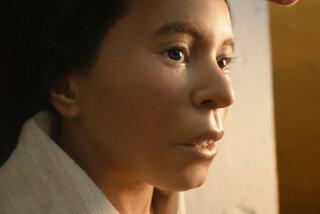Temple Opens Door to Ancient Culture
- Share via
CHIRIPA, Bolivia — A temple found near Lake Titicaca is the oldest ceremonial site ever found in the southern Andes and is providing new clues to one of South America’s most ancient civilizations, archeologists say.
Dated to 1500-1000 B.C., the semi-subterranean temple is from the Chiripa culture, which preceded the Incas by at least 2,500 years, said Dr. Christine Hastorf of UC Berkeley.
The find came at a site 11,800 feet up in the mountains where archeologists have been digging since 1992. Bolivian, American and British experts confirmed the temple ruins in July, said Hastorf, who led the team.
Parts of the temple, which is about 42 feet on a side, are still covered by red and yellow plaster. Archeologists have found grinding stones used to make pigments, ceramics with figures of monkeys and jaguars, obsidian, and a skull in a ceramic bowl.
Hastorf said they are finding new information about the living conditions, diet, pottery and tools of the Chiripa people who settled in the high Andes. They also are learning more about ritual activities and how those were integrated into daily life.
The discovery of skeletons of birds native to the tropics demonstrate that trading links existed between the highlands and lowlands far earlier than previously believed, Hastorf said.
Digging has uncovered six levels of human habitation at the excavation site, which is spread over 17 acres. The site has several pits with human remains, indicating that it was probably used as a ritual burial area.
Organic matter recovered at the site will be taken to the United States for analysis and dating. All cultural artifacts, however, remain in Bolivia, property of the National Institute of Archeology.
The Chiripas, whose civilization is thought to have lasted from 1500 B.C. to A.D. 200, were the first in the southern Andes to abandon a hunters’ lifestyle to become sedentary.
The newly found temple is considerably older than the previous oldest temple in the region, which has been dated to no earlier than 600 years B.C.
The best-known archeological site in the high Andes is Peru’s Machu Pichu, but it is far more recent, having been built in the 15th century. Mummies found in Paracas, in southern Peru, have been dated to 1000 B.C.
The earliest human habitation in South America is estimated at 13,000 B.C., with the first signs of human presence in the highlands coming about 4,000 years later after glaciers retreated.
The town of Chiripa is inhabited by Aymara Indians who are descendants of the Chiripa and Tiwanaku cultures that dominated the area long before the Inca conquerors swept down from Cuzco, Peru.
The farmers cultivate high-protein quinoa, potatoes, fava beans and grains, maintaining a way of life that in many ways has remained unchanged over the centuries.
Aymara farmers joined the team of archeologists in the search for their past. They sifted through tons of dirt in search of pottery and artifacts that help provide information on how their ancestors lived.
They say they hope the discoveries will encourage tourism.
Hastorf, who has been digging in the area for 20 years, said she needs to raise money for further excavations and also hopes to build a small museum and research center nearby.
Chiripa is 20 miles from the pre-Columbian city of Tiwanaku, considered one of the most important and oldest ceremonial sites in the continent.
Tiwanaku had a population of 1 million during its A.D. 759-1100 heyday and produced exquisite and now priceless textiles, ceramics, stone and metal objects. Today, large and elaborate stone carvings, including the gate of the sun and a puma monolith, can be found at the nearby ruins.
More to Read
Sign up for Essential California
The most important California stories and recommendations in your inbox every morning.
You may occasionally receive promotional content from the Los Angeles Times.










